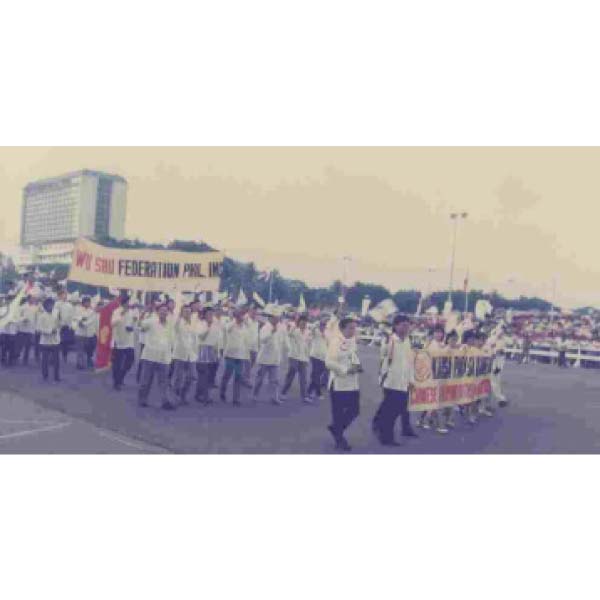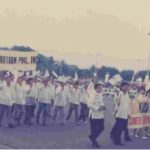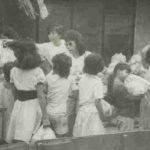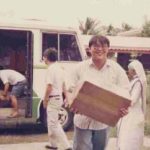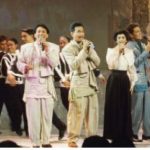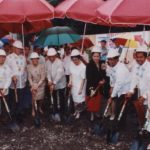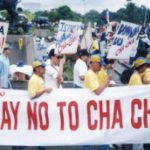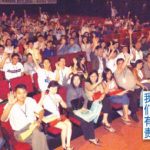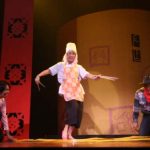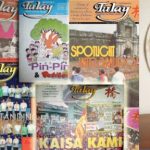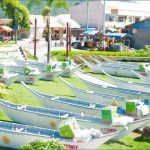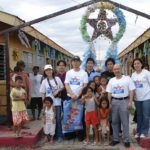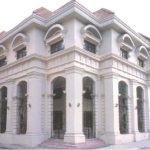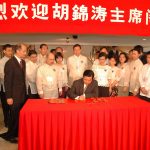1987
- Kaisa was formally launched at the National Press Club on August 28 as soldiers-turned-rebels led by Gregorio “Gringo” Honasan launched their bloody coup.
The weekly Chinese supplement Yong Hap (Integration) was started. Kaisa’s first book, Heritage: A pictorial history of the Chinese in the Philippines, was launched.
Kaisa, in collaboration with World News, launched Tulay Literary Journal, a quarterly. Four issues of the journal were published up to April 1988.
1988
- On June 12, the first Chinese-Filipino digest, Tulay Monthly, was launched. It evolved from the Tulay Literary Journal.
Kaisa and several Tsinoy organizations participated in the Philippine Independence Day parade at the Luneta. It was the first official participation of Chinese Filipinos in an Independence Day parade.
The Alay Medisina and Alay Puso projects began.
Kaisa convinced then Bureau of Immigration and Deportation Commissioner Miriam Santiago on the validity of an Alien Legalization Program. The program benefited many members of the Chinese community, thus greatly improving Kaisa’s standing in the community.
1989
- The monument honoring General Jose Ignacio Paua, the only full-blooded Chinese general in the Philippine revolution was unveiled in Silang, Cavite. It was built through donations from the Chinese-Filipino community.
1990
- “Pin-Pin,” the first and only bilingual children’s educational television show that highlights the role of the Chinese in Philippine life, first aired on June 13.
The Skills and Entrepreneurship Training project in 10 public schools was launched.
1991
- Kaisa went international by co-sponsoring the international conference on “The Chinese Overseas” with the De La Salle University.
“Pin-Pin” was recognized by the Gawad CCP as one of the Ten Best TV Shows for 1990.
1992
- “Tsinoy: A History of the Chinese in Philippine Life – in songs, dances and visual images” was shown at the PICC on Aug. 29. It was Kaisa’s first major fundraising campaign in celebration of its 5th founding anniversary. The term “Tsinoy” to mean Tsinong Pinoy was coined and has become popular.
The first cooperative efforts with two big traditional Chinese organizations were undertaken – one with the Federation of Filipino-Chinese Chambers of Commerce and Industry Inc. through the Heritage Exhibits displayed at the Rizal Park and at the Philtrade during Chinese New Year; the other with the Grand Family Association through the Hokkien-Tagalog and vice versa translation contest.
Kaisa officers pooled their resources to buy an office unit on the 11th floor of the State Center building on Juan Luna Street. The 120-sqm unit also housed the Kaisa library.
1993
- Tulay received two Catholic Mass Media Awards for Best in In-depth Reporting and Best in Advocacy. “Pin-Pin” was awarded a second time by the Gawad CCP as one of the Ten Best TV Shows for 1992.
Kaisa spearheaded the formation of the Movement for Restoration of Peace and Order to organize the funeral protest march for kidnap victim Charlene Sy on Jan. 13. Tsinoy schools and business establishments in Binondo and Banawe closed in unified protest.
Kaisa was co-convenors with the Citizens Action Against Crime that organized the biggest protest rally at the PICC to coincide with the National Summit on Peace and Order on Feb. 16, 1993. The Tsinoys, led by MRPO, gathered at the Luneta Grandstand and marched to PICC to meet other mainstream groups to protest against kidnappings and other violent crimes.
1994
- The first-ever national convention of Tsinoys was held at the Development Academy of the Philippines in Tagaytay on Aug. 20-21. The convention with the theme “The Tsinoys: Responding to Change and Challenge”, was attended by about 150 delegates from all over the country. It was in this convention that Dr. Angelo King, who was guest of honor, committed to help Kaisa build a Tsinoy cultural heritage center.
“Pin-Pin” was given a third recognition by the Gawad CCP as one of the Ten Best TV Shows for 1993.
An ecumenical mass officiated by Jaime Cardinal Sin was held at Binondo Church to commemorate Charlene Sy’s first death anniversary. All leading Tsinoy organizations joined the mass organized by Kaisa and MRPO.
1995
- Groundbreaking of the Kaisa-Angelo King Heritage Center in Intramuros, Manila on Aug. 27. It also marked the eighth anniversary of Kaisa. Guests included former president Corazon C. Aquino, Dr. Angelo King and his wife Belen King, then Manila Mayor Alfredo Lim, former senator Nikki Coseteng, and other government officials like Butch Abad, Juan Flavier, Bienvenido Tan Jr., Dondon Bagatsing and others.
Tulay Fortnightly was launched to replace the monthly issue.
1996
- Kaisa presented a paper on “The Ethnic Chinese in the Philippine Revolution” at the international conference on the 1896 Philippine revolution and launched the trilingual (English, Filipino and Chinese) monograph on the subject.
Kaisa sponsored an on-the-spot drawing contest for Metro Manila high schools with the theme, “Sentenaryo ng Rebolusyon: Ang Kahulugan Para Sa Akin,” held at the Luneta Grandstand on Aug. 25.
The Second National Tsinoy Convention, with the theme “The Tsinoys: New Roles and Responsibilities,” was held in Bacolod City on Sept. 7-8. The convention was attended by about 100 delegates from all over the country. Issues related to and those affecting the Chinese in the Philippines were discussed, including the peace and order situation, poverty alleviation, government corruption.
1997
- Alay Dunong, the brainchild of Lawrence Ong, was launched on April 4. The project sends Tsinoy volunteers to the countryside where they can share their expertise with farmers.
A street in Imus, Cavite was named Gen. Jose I. Paua Street on June 12 in the presence of Kaisa officers and members, Paua’s great granddaughter Fiona Paua, Cavite dignitaries headed by Imus Mayor Ireneo Malicsi and officers and members of the Lao-Na Association. A marker was placed in Camp Pantaleon Garcia where General Paua built an arsenal to manufacture weapons for the revolutionists with the help of Chinese in 30 days.
Kaisa launched six new publications at the National Commission for Culture and the Arts in Intramuros, Manila, in commemoration of Kaisa’s 10th anniversary.
“Tsinoy: Mga Anak ng Bayan,” a play based on the life and times of General Paua, wowed the audience at the PICC on Sept. 6-7. It was Kaisa’s second major fundraising campaign in celebration of its 10th anniversary and for the building of the Kaisa Heritage Center.
The 25th anniversary of the declaration of martial law is another milestone in Kaisa history. That day, Sept. 21, Kaisa members were not bystanders as significant events in our nation unfolded. “Kasama rin ang Kaisa” and “Tsinoy, ayaw din sa cha-cha” were the battle cries of Kaisa in “Marcha sa Luneta.”
On Nov. 29, Kaisa convened a multi-sectoral meeting at the Philippine Cultural High School to consult and feel the pulse of the community, whether they would be willing to join a funeral march for kidnap victim Gordon Tan and to close down shops. The Tsinoy Community Peace and Order Coordinating Council composed of 21 major organizations was formed. The funeral march proceeded on Dec. 2.
1998
- The First Tsinoy Youth Campference was held on April 3-5 at St. La Sallete grounds in Silang, Cavite with the theme, “Sandaang Taon: Ang Tsinoy may K maging Pinoy!”
Lupang Tinubuan: Mga Kasabihan Tungkol sa Bayan, translated into Filipino by Joaquin Sy, was launched at the residence of President Joseph Estrada on June 5. This is Kaisa’s offering in celebration of Philippine Independence Centennial.
On June 13, Kaisa joined the Freedom Fest Parade at the Quirino Grandstand in Rizal Park with its own float which measured 30-feet long atop a truck with the themes “Ang mga Tsinoy sa Rebolusyong Pilipino; Ang mga Tsinoy, Pinoy Din” and “Kami’s Kaisa, Karamay, Kabayan,” complete with props of canons and a large blacksmith’s steel anvil and at the back, a life-size photo of General Paua.
Kaisa unveiled the second monument of General Paua in Legaspi, built through donation from the Tsinoy community.
Kaisa celebrated its 11th anniversary on Aug. 30 with a book launching and the first blood-donation campaign.
Kaisa hosted the International Society for the Study of Chinese Overseas (ISSCO) conference at Century Park Hotel on November 26-27. It was attended by close to 200 delegates from six continents.
1999
- The Kaisa-Angelo King Heritage Center was inaugurated, with former president Corazon C. Aquino cutting the ceremonial ribbon, on Jan. 19.
Bahay Tsinoy: A Museum of the Chinese in Philippine Life opened to the public on February 1.
The replica of the terra cotta warrior, a gift from Chinese Ambassador Fu Ying, was unveiled at the lobby of the KHC on Nov. 8.
Madame Lao An, wife of Premier Zhu Rongji of China, visited Bahay Tsinoy end of November.
2000
- Kaisa launched four new publications at the Kaisa-Angelo King Heritage Center to celebrate its 13th anniversary in August.
Kaisa-Angelo King Heritage Center received from the Manila city government a special recognition award on urban renewal as part of the city’s 429th founding anniversary celebration.
In response to the Chinese Association for International Understanding’s invitation, Kaisa helped organize four delegations of nongovernment leaders for an exposure trip to China in between 2000 and 2001. The trips’ main objective was for the groups to see first-hand China’s progress since it opened up and embarked on its modernization program in the late 1970s. They were to learn from China’s experience and apply to the Philippines the lessons learned from the trip.
Under the banner “Tsinoys for Good Governance,” Kaisa members joined the Jericho March and the Senate vigil at the opening of President Joseph Estrada’s impeachment trial on Dec. 7.
Kaisa helped organized for the descendants of Jose Rizal to visit their hometown in Siongque, Fujian, China.
2001
- A Kaisa delegation was present at EDSA 2 (Jan. 17-20) when then President Estrada was ousted from office. Kaisa officers were part of the EDSA 2 convenors’ group.
Kaisa organized the third delegation of nongovernment organization leaders and media practitioners on a trip to China in April.
Kaisa officers sought and got the support of Benjamin Chua Jr., president of the Federation of Filipino-Chinese Chambers of Commerce and Industry, to build 14 units of schools for the seven Mangyan tribes of Mindoro.
Kaisa officers held an hour-long dialogue with former president Gloria Macapaal Arroyo to discuss pressing issues and to request her to endorse the 14 school houses in seven Mangyan communities in Mindoro.
Kaisa celebrated its 14th anniversary by launching five new books (four of which are Chinese translations of history books) and a blood donation drive.
Tulay received Catholic Mass Media Awards for Best Short Story.
2002
- Kaisa collaborated with the Manila Times in the first-ever search for outstanding Tsinoys for the the Dr. Jose Rizal Awards for Excellence in June.
Inauguration of the Tsinoys in Nation Building section of the Bahay Tsinoy museum on the third floor of KHC. Guests of honor were former President Corazaon Aquino, Vice President Teofisto Guingona, DECS Secretary Raul Roco and Manila Mayor Lito Atienza.
Tulay won Catholic Mass Media Awards for Best Feature for its issue on the life and times of the late Kaisa VP Lawrence Ong.
Kaisa started a fundraising campaign to set up the Lawrence Ong Trust Fund for Volunteer Efforts with Lawrence’s lifetime savings of P400,000 as seed money. More than P3,000,000 was raised. The trust fund was formally launched in August, in time for Kaisa’s 15th anniversary and Lawrence’s 1st death anniversary.
Li Peng, chairman of the standing committee of the National People’s Congress of China visited KHC in September. His visit was arranged by the House of Representatives.
Kaisa organized an official trip to China for the launching of the Encyclopedia on Chinese Overseas at the Great Hall of the People. Several dialogues with Chinese organizations and institutions were held.
2003
- Kaisa, in cooperation with the Chinese Embassy Cultural Office, launched a series of exhibits and film showings as part of the Department of Tourism’s Fiesta Tsinoy in Intramuros. The project was part of Visit the Philippines Year.
Kaisa again collaborated with the Manila Times for the Second Dr. Jose Rizal Awards for Excellence in June.
Wu Bangguo, Li Peng’s successor as chairman of the stannding committee of the National People’s Congress of China, visited the Kaisa Heritage Center in August.
To celebrate its 16th anniversary in August, Kaisa invited urban poor leader Ka Poneng to administer oathtaking for new board members. This highlights Kaisa’s thrust on poverty alleviation and nation building.
Tulay won Catholic Mass Media Awards for Best Short Story. Tulay was also a finalist for Best Feature.
Kaisa convened the Tsinoy Community Peace and Order Coordinating Council in November to issue anti-drugs manifestos and also mobilize the Chinese community for slain kidnap victim Betti Sy’s funeral march.
Kaisa joined Gawad Kalinga 777, the movement which aims to uplift poor communities all over the country.
Kaisa received the Outstanding National Volunteer Organization award from the United Nations Volunteers and the Philippine National Volunteer Services Coordinating Agency. The award was significant because out of more than a thousand nominees nationwide, only Kaisa and the Olongapo Volunteers won the award. It was a result of 16 years of hard work by Kaisa members.
The Antonio Roxas Chua Hall on the second floor of the Kaisa-Angelo King Heritage Center was inaugurated on Nov. 5, together with the opening of “His Dream, His Legacy,” an exhibit on the life and times of this late community leader.
2004
- Kaisa convened the Third National Tsinoy Convention with the theme “Nation Building: Kaisa Tayo!” on Feb 21-22 at the KHC auditorium. Close to 270 delegates from all over the country attended. The convention ended with the signing of the pact of solidarity to form the Tsinoys for Nation Building Coordinating Council.
Kaisa organized essay writing and drawing contests, with the theme “Tsinoy Youth in Nation Building,” for Tsinoy high school students. The Tsinoys for Nation Building Coordinating Council was formally organized in April. Composed of 12 major Tsinoy organizations, the council would coordinate the different social projects of the Tsinoy community to make these more focused on poverty alleviation.
Kaisa officers paid a courtesy visit to President Arroyo late March and presented her with a copy of the collection of archival materials on the Philippines from the Qing Dynasty. The collection is a joint project of Kaisa and the First National Historical Archives of China and funded by Dr. Lucio Tan.
Kaisa collaborated with the Manila Times for the Third Dr. Jose Rizal Awards for Excellence. For the first time, the awarding was held at KHC.
In celebration of the 29th anniversary of Philippines-China diplomatic ties in June, Kaisa with the Chinese Embassy and the Association for Philippines-China Understanding held the Peking Opera Photo and Teapot Exhibits at the KHC lobby.
Formal launching of updated Kaisa website in celebration of Kaisa’s 17th anniversary.
Kaisa led the Tsinoy community in a anti-gambling protest rally on Sept. 24 to oppose the plan of Philippine Amusement Gaming Corporation’s plan to operate a casino at the Binondo Suites in Ongpin, Manila. This was the first-ever rally held in the heartland of Chinatown.
2005
- President Hu Jintao, People’s Republic of China, visits Bahay Tsinoy.
Launch of Tsinoy – A Story of the Chinese in Philippine Life, a coffee-table book by Teresita Ang See.
Mounting of “Shared Heritage” exhibits in the Philippines and China commemorating the 30th anniversary of the establishment of PH-CN diplomatic relations. The exhibits were displayed at the Philippine embassy in Beijing and consulates in Shanghai, Guangzhou and Xiamen.
In partnership with the Fede-ration of Filipino-Chinese Associations in the Philippines
(菲華各界聯合會), Kaisa facilitated the visit of the Shandong descendants of the Sulu Sultan Paduka Batara to Manila, Zamboanga and finally to their hometown in Jolo, Sulu
Turnover of GK houses in Baseco, Tondo. The two villages were named Nayong Tsinoy and Oishi Village.
Kaisa collaborated with the Manila Times for the Fourth Dr. Jose Rizal Awards for Excellence at KHC.
2006
- “Zheng He’s Great Voyages (1405-1433)” exhibit in commemoration of the 600th anniversary of Zheng He’s voyage to the Nanyang
“Alab ng Puso” exhibit was displayed in celebration of Fire Prevention Month
“Herbs, Harmony and Health,” an exhibit that brings together the science and history behind traditional Chinese medicine, was our first offering as new member of the Zero In Consortium of Museums, comprising of Ateneo Art Gallery, Ayala Museum, Lopez Museum and Library and Museo Pambata. With Bahay Tsinoy, Zero-in focuses attention on the Tsinoy community that has made an indelible mark on the nation’s artistic and cultural fabric.
Received from the Federation of Filipino-Chinese Chambers of Commerce and Industry, Inc. the Most Outstanding Organization on Mass Housing award for its Gawad Kalinga projects.
Kaisa Heritage Foundation passed Philippine Council for NGO Certification standards and is granted a three-year certification for donee institution status.
Kaisa’s extensive research materials on Chinese in the Philippines are now on microfilm through the funds the US Library of Congress and the Genealogical Society of Utah.
Kaisa collaborated with the Manila Times for the Fifth Dr. Jose Rizal Awards for Excellence at KHC.
Turnover of GK houses in Escalante, Negros Occidental and Bamban, Tarlac for the Aetas.
2007
- Awarded the Parangal Lingkod Sambayanan by Ateneo de Manila University “for asserting the place and unique contribution of the Chinese in the Philippines; for serving as a bridge between the Filipino and Chinese communities through a multitude of cultural and educational projects; and for tapping the boundless energies of Chinese-Filipino youth for the task of nation-building.”
Awarded the Tuklas Katutubo Award from the Pambansang Samahan ng mga Kabataang Katutubo sa Pilipinas “in various efforts to help the indigenous minorities – among them the Mangyans in Mindoro, Aetas in Kanawan and Bamban, and Muslims in Mindanao.”
Staged “Tsinoy: Kaisa Ka!” Kaisa’s 20th anniversary musical revue on significant vignettes in the history of the Chinese in Philippine life. It is also Kaisa’s tribute to the men and women who lived their lives for others, who committed themselves to make a difference in our nation and gave their unwavering support that enabled Kaisa to reach its goals, fulfill its visions and now dare to soar to greater heights.
“Comida China” is BahayTsinoy’s contribution to “Zero In: Hybridity.” Taking off from the theme, the specific interpretative frames constructed by each museum pitches for a critical re-thinking of what and how fusions are realized. On its sixth year, the Zero-In museum consortium takes on the notion of the crossbreed in this joint institutional exploration of likeness and variance.
Turnover of GK houses (Oishi Village) in Purok Pag-asa sa Aguado, Trese Martirez, Cavite.
2008
- “Zero In 7 Bridges: Treasures and Heritage.” Bahay Tsinoy mounted a selection of trade ceramics from the collection of Juan T. Lim that offered glimpses of the wealth of pre-Hispanic Philippines and its extensive relations with China.
The Pao Shih Tien Hall on the third floor of the Kaisa-Angelo King Heritage Center was inaugurated on March 9 on his 100th birth anniversary.
Kaisa collaborated with the Manila Times for the Sixth Dr. Jose Rizal Awards for Excellence.
Turnover of GK houses in St. Bernard, Southern Leyte.
2009
- “Bittersweet: Documentary Exhibit on the Chinese in Philippine Colonial History” to celebrate the 10th anniversary celebration of Kaisa Heritage Center
“Zero In 8: Remembering,” an exhibit on the Nanjing Massacre. Nov. 7- 27.
The Teh Siu Yong Limpe Hall on the third floor of the Kaisa-Angelo King Heritage Center was inaugurated on May 6 to honor this exemplary and unique philanthropist, civil worker and educator.
The family of former president Corazon Aquino, represented by son Senator Noynoy Aquino and daughter Viel Aquino-Dee, turned over memorabilia of the late leader to the Bahay Tsinoy on Sept. 23. The Aquino siblings also took the opportunity to formally thank the Tsinoy community – including volunteer firefighter groups, students and the Kaisa Heritage Center staff – for their help and support during the wake and funeral of President Cory last August. The Center served the Secretariat for the wake at the Manila Cathedral.
Massive Ondoy relief operations (from Benguet to Southern Tagalog Region), Sept. 28-Nov. 17.
Children orphaned by the 2008 earthquake in Sichuan province, China visit Bahay Tsinoy.
Turnover of GK houses in Maralit, Parañaque.
Kaisa promoted the children’s rights to be nurtured and protected through Kaisa sa 0-6, an early childhood care and development program.
2010
- Film showing at Kaisa and other Tsinoy schools of “Tsinoy: Kaisa Ka!”
Zero In Consortium launched a five-museum exhibit at Greenbelt 5, Makati to introduce our museums to different audiences.
Kaisa collaborated with the Manila Times for the Seventh Dr. Jose Rizal Awards for Excellence.
Teresita Ang See was the representative of the Tsinoy community in the fact-finding committee of the hostage-taking crisis that saw the deaths of Hong Kong tourists at the Rizal Park.
2011
- In the spirit of volunteerism and the celebration of Rizal’s 150th birth anniversary, Kaisa and the Caloocan City Filipino Chinese Fire Prevention Association, Inc., held the Intramuros Heritage Run on May 15. Proceeds of the run was donated to Kaisa-PGH Alay Medisina, an ongoing medical assistance program for the last two decades, the rehabilitation of Bahay Tsinoy Museum, and the rehabilitation of the CCFCFPAI volunteer fire station.
Relief operations for victims of typhoons Pedring and Quiel.
2012
- Fourth Tsinoy National Convention in celebration of the 25th anniversary of Kaisa.
Build a Bridge Leadership Training workshop for student leaders of Tsinoy Schools.
2013
- Bahay Tsinoy joins Pasinaya, the annual arts festival of the Cultural Center of the Philippines and mounts “You Speak Hokkien,” an exhibit showcasing every day Filipino words derived from Hokkien.
Massive relief operations for people displaced by the Typhoon Maring and habagat monsoon (Taytay, Cainta and Binangonan Rizal; Biñan, Sta Rosa, Cabuyao, Sta Cruz in Laguna, and Kawit, Cavite).
Zero In Consortium conducts the second National Workshop on Establishing Community Museums in Davao City.
Yolanda relief operations and Bangkabuhayan project (motorized boats for fishermen displaced by typhoon Yolanda) Nov. 13 to May 2014. Kaisa received a HK$2-million grant from the HK government for the relief operations.
Kaisa convened the Tsinoy Nation Building Consortium to coordinate efforts of different Tsinoy NGOs for sustainable development in the Philippines.
Kaisa launched the book Chinese in the Philippines: Problems and Perspectives, vol. 4 as part of its 26th anniversary celebration in August.
2014
- “10,000 Stories,” an exhibit of volunteer stories from Tsinoys across the Philippines.
Pasinaya 2014: Bahay Tsinoy joins CCP for its annual arts festival. This year, they launched the Museum Mile.
HKDRF (Hong Kong Government Disaster Relief Fund) funds Kaisa’s Yolanda relief efforts with a grant of HK$500,000.
Distribution of boats through the Bangkabuhayan program. A total of 350 boats were given away in 2014.
Zero In Consortium conducts the Second National Workshop on Establishing Community Museums in Davao City.
Turnover of GK houses in Cateel and Mati, Davao Oriental.
Kaisa received the Gawad Pasasalamat from the Bureau of Fisheries and Aquatic Resources on Oct. 17 for its contributions to the rehabilitation efforts after Supertyphoon Yolanda hit the country in 2013.
2015
- Pasinaya 2015: Auspicious Art. Prints of the 12 animal zodiacs from the collection of Nancy Lu.
“Remembering history, Honoring heroes,” in commemoration of the 70th year of the end of WWII mounted with the descendants of the Wha Chi guerrillas.
Zero In Consortium conducts the Third National Workshop on Establishing Community Museums in Bacolod City.
Kaisa conducted a seminar workshop on Aug. 5 entitled “Death, Burial Rituals and Cemeteries among Chinese Communities of Insular Southeast Asia.” This was held in KHC with participants from Malaysia, Japan, France, Taiwan, US and the Philippines.
2016
- Pasinaya 2016. Bahay Tsinoy hosts the museum mile once more.
Exhibition of “Ancient Buddhist Manuscripts” brought to the Philippines by Buddhist Minister Phrabommasith of Thailand.
2017
- Grand reunion in January of Kaisa members and members of its predecessor Pagkakaisa to spearhead Kaisa’s 30th anniversary year-long celebration.
Vice-premier of PROC Wang Yang visited Bahay Tsinoy in March.
Pasinaya 2017. BahayTsinoy hosts the museum mile once more
In commemoration of the 600th year of the visit of the Sultan of Sulu to China, Kaisa opened “600 years of enduring friendship – beyond borders, beyond time” and launched the monograph The Ties that Bind: the Saga of the Sultan of Sulu in China.
Book Free: The Chinben See Memorial Library invited public school teachers and librarians to come to Kaisa and shop for books for free. About 260 teachers and librarians took home stocks of donated books that are not part of our library collections.
Pamana – Kaisa at 30 – celebration of Kaisa’s 30th anniversary with blood donation and the opening of the third floor Chinese Literary Room (菲律濱華文文學館) extension of the Chinben See Memorial Library.
